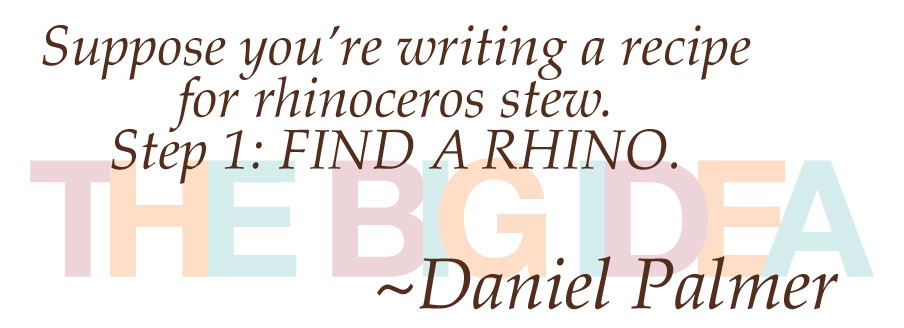While at ThrillerFest, I had a chance to attend a couple of talks that discussed plot and story structure, though even then those sessions did also emphasize the importance of character. In fact, if I were to pinpoint a theme of all the panels I sat in on at the conference, I would say that it would be: building dimensional characters and staying true to them. Even in the plot-centered panels and talks, the speakers stressed how important it is to make sure that plot serves the character at least as much as character serves the plot.
One of my favorite talks was by Daniel Palmer, who offered a step-by-step look at how to develop an idea into a story. This talk combined with David Morrell’s excellent and inspiring speech on story structure have given me a lot to think about in terms of plot. But first, let’s look at Daniel Palmer’s step-by-step approach.
Step 1: The Rhino
The Rhino is the Big Idea for a story. Nuclear bomb in LA, identity theft, magic school, aliens attack, “I see dead people.” These are all rhinos. They’re the big ideas for stories but they are nothing near what the real story is. After all, ideas are not books. Books are books.
Step 2: The “What If?” Question
This is where you turn that rhino into something resembling an elevator pitch. The “What If?” question shouldn’t be very long–one or two sentences at most–but it encapsulates the overall story and gets the audience enticed to know more. Examples of a “What If?” question might be:
- What an ordinary boy found out that he was actually a wizard and that his arch-nemesis was the most evil wizard of all time? (Harry Potter series)
- What if a counter-terrorist unit discovers that there is a nuclear bomb hidden somewhere in LA and the only person who can stop it has left the unit and refuses to come back? (24 season 2)
- What if, in the course of treating a young patient, a psychiatrist realizes that the boy can, in fact, see dead people? (The Sixth Sense)
Step 3: The McGuffin
This term was originally coined by Alfred Hitchcock to describe that critical question that describes the mystery behind the story. “Who released the deadly virus?” “Who made the bomb?” These are examples of McGuffins, but as Daniel Palmer explained in his talk, the McGuffin doesn’t really mean much of anything. Readers think they’re reading a book to find out the answer, but the thing that really hooks the readers, what makes them read to the end are the characters not the McGuffin. As Palmer said, the point of the McGuffin is to give some sense to the story. After all, the writer needs to know the answer to the McGuffin in order to write the book. But once you have that answer, you need to put that McGuffin away and focus on Step 4.
Step 4: The Characters
Who will you write about? Who has the most at stake in this story? Who’s the most vulnerable? Daniel Palmer suggested creating a protagonist who would have the absolute most at stake in the story. Not only that, the key is to throw your character into that bubbling rhino stew, and force them to figure a way out of that mess. In other words, you make the character solve the problem in the story instead of making someone else solve it for him or her. Ultimately, while there are some mechanics of story structure at work, the key element to creating a good story is the character.
Where Story Structure Comes Into Play
Devices can help shape a story and give it structure. According to David Morrell, oftentimes a story will come to life once you figure out the overall structure. He talked about the movie High Noon where the writers edited out the flashbacks explaining the story and replaced it with the ticking clock. Similarly, with his own book First Blood (the book on which the movie Rambo was based), Morrell used an A-B-A-B-A-B-etc. structure with alternating points of view, a structure which added depth to the story. In a different book, Creepers, Morrell wrote in such a way that the story would unfold in “real time” and took place in one-hour chunks over the course of a night.
But this idea of using devices to structure a story is nothing new. Faulkner used it in his book The Sound and the Fury in which each section of the book is told from a separate point of view. Or what about Agatha Christie’s And Then There Were None? In that book, each dead body turns up killed in a way that reflects a line of a nursery rhyme. These are all devices that lend structure and help unify a story.
Morrell warned against trying to structure a book based on what the market dictates. “Don’t chase the market,” he said. “Write your book with the understanding that the most valuable thing you have is time.” He explained that if time is our most valuable commodity, and books can take months or years to write, then you want to make sure you’re writing a book that really speaks to you. He calls it the “metaphorical autobiography of your soul.” Because if you go into writing focused on getting published or becoming a bestseller you’re bound to be disappointed. But if you go into it wanting to write a book that is meaningful to you, then no matter the outcome, you won’t have wasted that time because the book means something to you.
As Morrell repeated several times in his speech, (a quote originally coined by Judy Garland):
“Be a first rate version of yourself and not a second rate version of someone else.”
I don’t know about you, but I sure am going to try.







